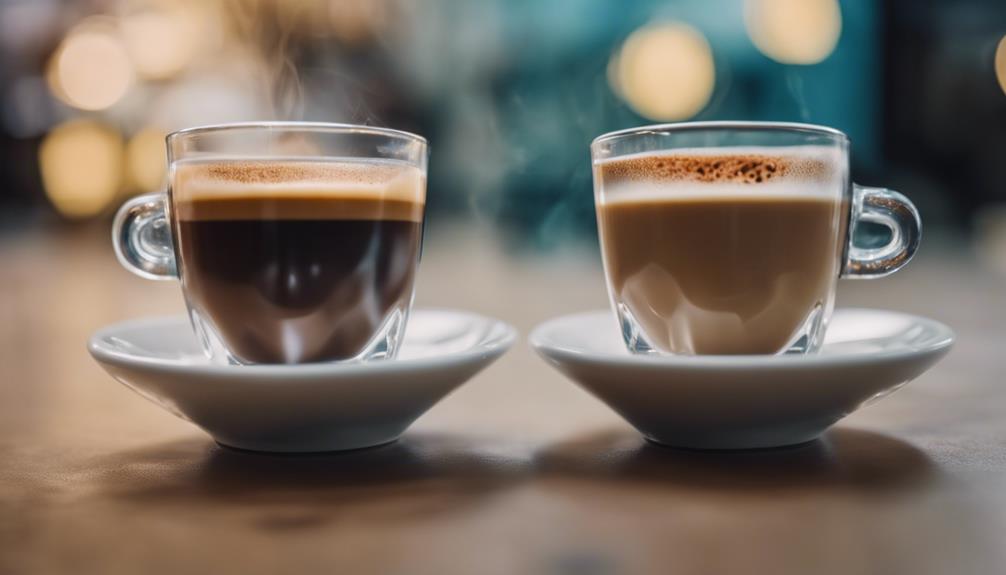Espresso shots do not expire, but their taste changes due to oxidation. This process alters the flavor profile over time, affecting the bitterness and acidity levels. For the best taste experience, consume promptly after extraction as freshness greatly impacts the flavor. Refrigerating espresso shots can prolong their freshness for 4-5 days, maintaining taste consistency. Understanding oxidation and proper storage methods can enhance your appreciation of espresso. Remember, the longer espresso sits, the more the flavor evolves. Explore the nuances of aged espresso for a unique tasting experience.
Key Takeaways
- Espresso shots do not technically expire but deteriorate in flavor rapidly.
- Freshness impacts taste significantly, with flavor evolving over time.
- Aging espresso shots intensify bitterness and acidity.
- Prompt consumption is recommended to enjoy peak flavor.
- Proper storage can prolong the freshness of espresso shots.
Freshness of Espresso Shots
To fully appreciate the flavor of espresso shots, consume them promptly after extraction to savor their peak freshness. Espresso shots begin to lose their best taste within 10 seconds of being brewed due to crema integration, color changes, and oxidation.
The gradual oxidation process affects the flavor over a few minutes rather than an instant decline. It's recommended to enjoy espresso shots within a minute of brewing to experience the full flavor profile before acidity and bitterness increase.
Storing espresso shots in airtight containers can help delay oxidation and preserve freshness for a limited time. As time passes, the levels of bitterness and acidity in espresso shots intensify, underscoring the importance of savoring them promptly for the best taste experience.
Oxidation Process of Espresso

Oxidation is a natural process that gradually alters the flavor of espresso over time. As soon as your espresso shot is pulled, oxidation begins its subtle impact on the taste.
Storing your espresso properly can help slow down this process and preserve the quality of your brew.
Oxidation in Espresso
The gradual process of oxidation in espresso alters its flavor over time. Oxidation, a natural chemical reaction, is responsible for the changes you may notice in the taste profile of your espresso. Initially, espresso can maintain its flavor for a few minutes before oxidation begins to take its toll. Proper storage techniques can help delay this oxidation process, allowing you to enjoy your espresso before significant flavor changes occur.
To visualize the impact of oxidation, consider the following table:
| Time Since Brewing | Flavor Profile | Aroma |
|---|---|---|
| 0 minutes | Rich, bold | Intense and inviting |
| 15 minutes | Slightly bitter | Aroma starts to fade |
| 30 minutes | Flat and dull | Aroma diminishes noticeably |
Understanding how oxidation affects your espresso can enhance your appreciation for this beloved beverage and guide you in savoring it at its best.
Effects on Flavor
Understanding how oxidation gradually alters the flavor of espresso over time is essential for appreciating the nuances of this beverage. Oxidation, a natural chemical reaction, begins as soon as espresso is brewed. As oxygen interacts with the compounds in espresso, subtle changes in flavor occur.
Initially, espresso may maintain its rich taste for a few minutes before oxidation starts to impact its quality. Rushing to consume your espresso may cause you to miss the gradual flavor changes brought about by oxidation.
Properly storing your espresso can help delay the oxidation process, preserving its taste for longer periods. By keeping your espresso in an airtight container away from light, heat, and moisture, you can slow down the oxidation rate and enjoy a more consistent flavor profile.
Storage Recommendations
To preserve the freshness and flavor of your espresso shots, it's essential to store them properly in an airtight container. When it comes to storing espresso, consider the following tips:
- Airtight Containers: Opt for containers that seal tightly to minimize exposure to air and slow down the oxidation process.
- Cool, Dark Place: Store the espresso in a cool, dark place away from heat sources to maintain its quality for a longer period.
- Avoid Moisture: Keep the espresso away from moisture as it can affect the flavor and quality of the shots over time.
Oxidation is a gradual process that occurs when espresso shots come into contact with air, leading to changes in flavor and aroma. By storing your espresso properly in airtight containers and following these recommendations, you can help delay oxidation and enjoy your espresso shots at their best.
Flavor Changes Over Time

As espresso shots age, their taste undergoes changes due to oxidation, impacting the overall flavor profile.
The freshness of the espresso shot plays a critical role in how enjoyable it is to drink, as the aging process can lead to increased bitterness and acidity.
To experience the best taste, it's advisable to consume espresso shots promptly after brewing to savor their peak flavor.
Aging Affects Taste
As espresso shots age, their flavor profile undergoes changes due to the process of oxidation. Over time, the taste of your espresso can transform, impacting your overall coffee experience. Here are some key points to ponder about how aging affects the taste of espresso:
- Increased Bitterness and Acidity: As espresso sits, it can become more bitter and acidic, altering the balance of flavors in your shot.
- Evolving Taste: The flavors in espresso can shift and evolve as it ages, with some initial notes fading away while others become more pronounced.
- Gradual Oxidation Process: Oxidation in espresso is a gradual process that occurs over minutes, not instantly, leading to a slow progression of flavor changes.
Understanding how aging affects the taste of your espresso can help you appreciate the nuances in flavor development and make informed decisions about when to enjoy your shots for the best taste experience.
Freshness Impacts Flavor
Fresh espresso shots undergo flavor changes over time due to the impact of oxidation and compound degradation. As espresso sits, oxidation gradually alters its taste, leading to shifts in bitterness and acidity levels. Stale espresso shots can exhibit a bitter, sour, or acidic taste, signaling a loss of freshness. The crema, an important component of espresso, diminishes over time, while bitterness and acidity intensify, affecting the overall flavor profile. To better understand the impact of freshness on flavor, let's take a closer look at how oxidation influences the taste of espresso:
| Freshness Level | Flavor Profile |
|---|---|
| Fresh | Balanced and vibrant |
| Aged (1-2 hours) | Slightly intensified bitterness |
| Stale (4+ hours) | Pronounced bitterness and increased acidity |
Proper storage and timely consumption are essential to preserving the excellent flavor of espresso shots and ensuring a delightful coffee experience.
Best Time to Consume Espresso

For the ultimate espresso experience, aim to savor your shot within one minute of brewing to capture its peak flavor profile. Here are some key points to keep in mind when enjoying your shot of espresso:
- Immediate Consumption: Flavor changes occur rapidly, with oxidation impacting taste as time passes.
- Crema Integration: The crema enhances the flavor, but color changes and taste degradation begin after just 10 seconds.
- Savoring the Moment: Rushing to drink your espresso may cause you to miss out on the nuanced flavors it has to offer.
Taking the time to appreciate your espresso shot slowly allows for a deeper understanding of its taste profile. By consuming it promptly, you can enjoy the full-bodied richness and complexity that a freshly brewed shot of espresso has to offer.
Fridge Storage for Espresso

Storing espresso in the fridge can help prolong its freshness and preserve its flavor over a longer period. Espresso can last 4-5 days in the fridge, maintaining its quality.
To make sure your espresso stays fresh, it's essential to store it in properly sealed airtight containers. This method of storage helps prevent rapid deterioration, keeping your espresso tasting great for a few extra days.
Refrigerating brewed espresso is recommended if you want to enjoy it over multiple days without sacrificing its flavor. By following this simple storage tip, you can extend the shelf life of your espresso and continue to savor its rich taste.
Shelf Life of Espresso

When considering the shelf life of espresso, it's important to take into account factors such as storage method and exposure to air.
To guarantee your espresso stays fresh and flavorful, follow these guidelines:
- Brewed espresso typically lasts for about 4-5 days when stored in the refrigerator.
- Ground espresso beans can stay fresh for 3-4 weeks when stored in the fridge.
- Stale espresso may taste bitter, sour, and acidic due to oxidation and degradation.
Espresso that has surpassed its shelf life may develop a bitter taste, losing its rich aroma and bold flavor profile. Airtight storage is essential in preserving the freshness of espresso, preventing it from being exposed to air and moisture that can accelerate the degradation process.
Storing Roasted Coffee Beans

To maintain the freshness and flavor of roasted coffee beans, proper storage is essential. It's recommended to store roasted coffee beans at room temperature or in the fridge to guarantee their longevity.
Using airtight containers is vital in preserving the rich flavors of the beans. When storing in the fridge, the freshness of roasted coffee beans can be extended for up to 4 weeks. Make sure that the containers are tightly sealed to prevent any odors from infiltrating and altering the taste of the beans.
By following these storage guidelines diligently, you can help maintain the quality of your roasted coffee beans, ensuring that each brew delivers a delightful and aromatic experience.
Utilizing Aged Espresso

Aged espresso offers a unique and complex flavor profile that develops over time as it sits. If you're curious about exploring the world of aged espresso, here are some things to take into account:
- Enhanced Complexity: Aged espresso can develop a more intricate taste profile as it matures, offering subtle nuances that may not be present in freshly brewed espresso.
- Mellowed Taste: Some coffee enthusiasts prefer aged espresso for its mellowed flavors, which can provide a smoother and more balanced drinking experience.
- Oxidation Process: Through gradual oxidation and flavor changes, aged espresso undergoes a transformation that enhances its complexity and depth.
Experimenting with aged espresso can open up a new domain of flavors and textures to explore, allowing you to appreciate the drink's evolution over time. While aged espresso may lose some of its vibrancy, it gains a unique character that appeals to those seeking a different coffee experience.
Frequently Asked Questions
How Long Do Espresso Shots Last?
Espresso shots typically last for about 10 seconds before flavor and appearance changes become noticeable.
Oxidation and crema breakdown impact taste and visual appeal over time. To enjoy peak flavor, it's recommended to consume espresso shots within one minute of extraction.
As espresso shots sit, acidity and bitterness increase, altering the taste profile. Storing them in airtight containers or drinking promptly helps maintain freshness and flavor.
What Is the 10 Second Rule for Espresso?
The 10-second rule for espresso is a guideline suggesting you enjoy your shot within 10 seconds of it being served. This recommendation aims to capture the peak flavor and aroma of the espresso.
By savoring the shot promptly, you can experience the rich taste and nuances before any potential flavor changes due to oxidation.
Following this guideline allows you to appreciate the espresso's full sensory experience while it's at its freshest.
What Is the Life Span of an Espresso Shot?
The lifespan of an espresso shot is quite short, my friend. Once it's brewed, you've got about a minute to savor its peak flavor before it starts to change.
Oxidation and degradation processes kick in fast, affecting the taste. So, to enjoy that perfect shot, don't let it linger too long.
Does Espresso Actually Expire?
Espresso shots don't have a definite expiration but change gradually due to oxidation. It's recommended to consume espresso quickly after brewing for best taste.
Oxidation alters the flavor, increasing bitterness and acidity over time. Proper storage can maintain flavor for a few minutes. Rushing through consumption may lead to missing out on nuanced flavors.
Enjoying espresso promptly allows you to savor its complexities before flavor changes become noticeable.
Can Expired Espresso Shots Be Harmful to Your Health?
While consuming expired espresso shots may not immediately result in serious health effects, it can lead to potential side effects such as stomach discomfort, nausea, and increased heart rate. It’s best to avoid consuming expired espresso shots to prevent any potential harm to your health.
What is the shelf life of Espresso Shots?
The espresso shot storage time varies depending on various factors such as the type of espresso machine used, the temperature of the storage environment, and the method of storage. Generally, properly stored espresso shots can last up to 12 hours before their quality begins to deteriorate.
Conclusion
Just like a fine wine, espresso shots do have an expiration date. While they won't go bad like milk, their flavor will diminish over time due to oxidation.
To enjoy the full richness and complexity of your espresso, it's best to consume it soon after brewing.
However, if stored properly in the fridge or as roasted coffee beans, you can still savor a decent cup even as it ages.
So, seize the moment and savor every sip while it lasts.









